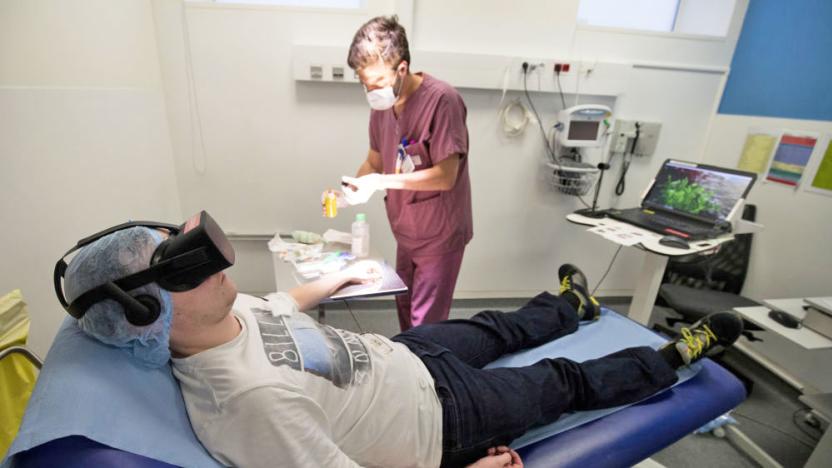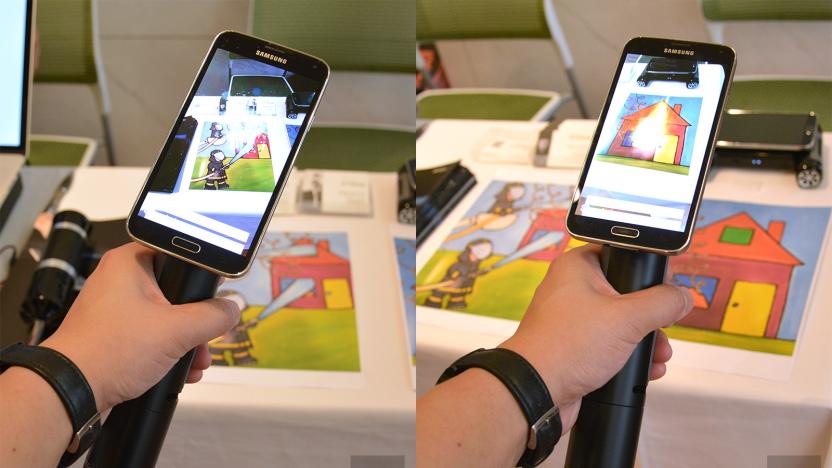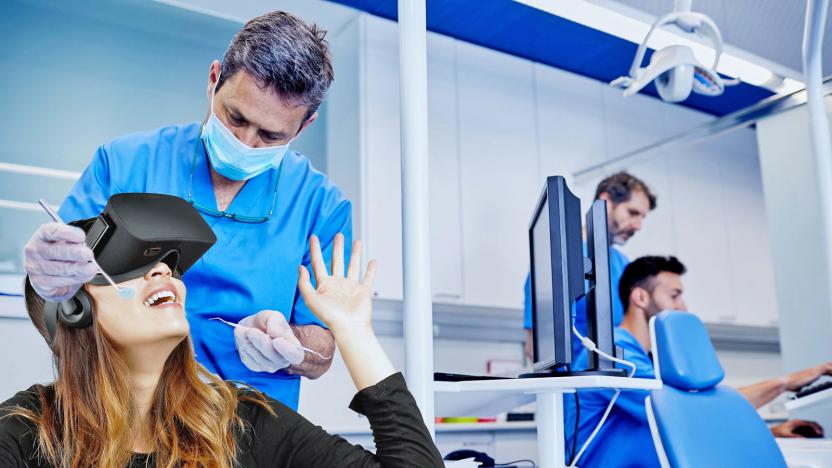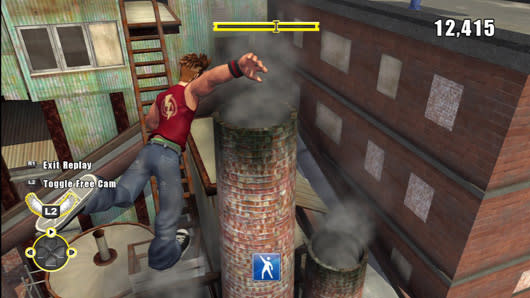pain
Latest

A French hospital is using VR as a drug-free pain solution
The use of virtual reality (and even video games) as an alternative form of pain management isn't exactly unheard of. Researchers are well aware of VR's potential to distract patients at the dentist and combat phantom pains, so it shouldn't be a surprise to see VR turning up in the emergency room. Graduate students at St Joseph's Hospital, France, have designed an immersive virtual program that is being used to help patients relax and increase pain tolerance without painkillers.

ThermoReal lets you feel heat, cold and even pain in VR and AR
While some companies are trying to make AR and VR more immersive via haptic feedback, one startup decided to focus on the thermal aspects of the experience. TEGway, a spin-off of the Korea Advanced Institute of Science and Technology, has created a slim, flexible thermo-electric device (or "TED" in short) that can rapidly heat up or cool down, covering a temperature range of 4 to 40 degrees Celsius (39.2 to 104 degrees Fahrenheit). Better yet, it can simultaneously produce both heat and cold in different zones on the same surface, which enables the simulation of a pinch on one's skin to produce pain. Now packaged as ThermoReal, the company is hoping hardware makers will integrate this solution into the likes of joysticks, gloves, haptic suits, chairs and more for a new level of immersiveness.

Researchers are using VR to make dentist visits less painful
Like airlines, dentists understand that the more they can distract you from what they're doing, the better off everyone will be. UK researchers wanted see if virtual reality can ease patient pain and anxiety, so they enlisted 79 people who needed a tooth pulled or cavity filled. Patients were divided into three groups: One that viewed a VR coastal scene, one a VR city, and the other, no virtual reality at all.

23andMe study focuses on why we experience pain differently
We all experience pain differently, and what's excruciating for you might not even be worth mentioning for another. There are studies that looked into the difference in pain tolerance between individuals and some even found associations between people's pain tolerance and their gender and ethnicity. 23andMe wants to have an even deeper understanding of pain tolerance and to finally figure out what role genetics play in both temporary and chronic pain. That's why it has teamed up with German-based pharmaceutical company Grünenthal to conduct one of the largest studies of its kind.

Gene editing could lead to a vaccine for arthritis
Right now, arthritis treatment tends to be an all-or-nothing proposition: the drugs you take affect your entire body, causing havoc with your immune system and leaving you prone to infections. But how do you narrow the treatment to just those areas where you feel pain? Genetics, apparently. Researchers have used CRISPR gene editing to turn stem cells into cartilage that releases a biological anti-inflammatory drug when they encounter inflammation. It not only limits treatment to the affected area, but responds only when there's a pain flare. You only get relief when you need it.

Snail venom provides a new way to treat chronic pain
The Conus regius' venom is bad news for its prey, and it's been proven harmful to humans as well. For instance, a 2009 clinical case describes a diver who had trouble moving his arm for 12 hours after an attack. However, scientists from the University of Utah see hope in the ocean dweller's powerful venom. In fact, research suggests it could be used to develop a new treatment for chronic pain.

LED implants could ease your pain
One day, eliminating pain may just be a matter of flicking on a light. Scientists have shown that you can implant LEDs that stop neurons from firing and cut out pain reception. The current technique (tested in mice) requires altering the neurons' DNA -- you couldn't just stick them in anyone. They're soft, however, and safe enough that you can leave them under the skin for long periods of time without limiting motion or wrecking tissue.

Scientists track fish health by 'finding Nemo'
While a Fitbit isn't much use to a flounder, a team at the University of Liverpool has figured out the next best thing. Dr Lynne Sneddon's team created a system that non-invasively monitors the welfare of our sub-aquatic friends. Two cameras monitor how healthy fish swim in three dimensions, while software picks out any critters showing irregular patterns. Any real-life Nemos get given a health score, alerting carers to which animals might need attention.

Computers can tell how much pain you're in by looking at your face
Remember Baymax's pain scale in Big Hero 6? In the real world, machines might not even need to ask whether or not you're hurting -- they'll already know. UC San Diego researchers have developed a computer vision algorithm that can gauge your pain levels by looking at your facial expressions. If you're wincing, for example, you're probably in more agony than you are if you're just furrowing your brow. The code isn't as good at detecting your pain as your parents (who've had years of experience), but it's up to the level of an astute nurse.

China has a microwave pain weapon of its own
The US may never have used its microwave pain gun in combat, but that isn't stopping China from exploring the concept of non-lethal force. Local manufacturer Poly has unveiled the WB-1, a millimeter-wave weapon that heats the water under your skin (much like the US' Active Denial System) to deliver intense agony without injury. It currently works at a relatively short range of about 262 feet, but extra power can bump that up to 0.6 miles -- if you know where to shoot, you could cause misery from afar. It's reportedly meant to be used on the high seas, where it could enforce China's territorial claims without the need to capture or destroy wayward vessels.

PSN ragdoll injury sim Pain returning as free-to-play game
Idol Minds' ragdoll-abusing action game Pain will return to the PlayStation Network as a free-to-play title, Sony Brazil revealed this week. The revised version of Pain is developed by Argentinian studio QB9, which Sony recently recruited as part of its Latin American indie incubation program. Footage shown at the ongoing Brazil Game Show indicated that the free-to-play version of Pain will retain all gameplay features and modes from the original 2007 release, including the popular multiplayer Bowling mode. A release date for the new free-to-play version of Pain has not been announced.

Amazon's political reading map shows which way your neighbors are leaning
Religion, bathroom routines and politics are three things you should never, ever discuss at the dinner table. However, if you're curious about your neighbors' political reading habits, then you should check out Amazon's Election Heat Map. The bookseller rated the top 250 books with a "clear political bias," with each state's graphic turning red or blue depending on which tomes are selling the most. The company is clear to say that the results are more for the curious than a reflection on the result of the election, so if you fancy checking it out, head down to the source link.

SnowWorld breathes new life into severely burned Afghanistan veteran
We know video games can offer deeply immersive experiences that affect our real-world emotions and draw intense reactions from our real-life bodies and minds. We know this, and finally the professional medical community is beginning to recognize our insight, with truly encouraging results, as described by GQ's recent feature, Burning Man.Sam Brown's body was burned horrifically during his tour in Afghanistan, after his Humvee ran over an IED, GQ writes. He spent many months after the accident drugged out of consciousness on rave-grade hallucinogens and enduring the highest levels of physiological pain during therapy that no amount of morpihne could tame. And then a cognitive psychologist told him to play SnowWorld, a virtual-reality game full of snowball-chucking snowmen and penguins, while his skin was stretched, a procedure that normally garnered a score over 10 on Brown's pain scale.Playing SnowWorld, he gave the pain a six.Hunter Hoffman, the psychologist behind SnowWorld, is working on further research into the art of pain distraction through video games, but already results such as Brown's show great potential. Hoffman is using $7.5 million in grants from the National Institutes of Health to expand his research, including the incorporation of Second Life-style elements into video game therapy. Read the entire, captivating story at GQ. [Image via MGShelton]

GDC Online 2011: BioWare's Damion Schubert takes a wrecking ball to the casual vs. hardcore model
"I'm trying to finish a product, Star Wars: The Old Republic, which I am not going to talk about today." Thus began BioWare's Damion Schubert's seminar, Double Coding: Making Online Games for Both the Casual and the Hardcore, at this year's GDC Online. "This is more of a weary man, sort of stream-of-consciousness design theory talk." Schubert wanted to call the talk "Moving Beyond Double Coding," which is a term that comes from cartoons, of all places. Double coding is content that reaches two different groups of people at the same time. Looney Tunes, for example, would entertain both adults and kids because the writers and animators designed it so. With MMOs, Schubert says that devs are often trying to double code the games for both casual and hardcore players. This is where the well-known slogan "easy to play, hard to master" originates. He held up Blizzard as a primary example of this model. Blizzard's "donut," as Schubert calls it, has a casual outer ring and a hardcore center for both types of players. By double coding, Blizzard ensures that casual players can invite their hardcore friends to experience the game and vice-versa. However, this model is faltering, and Schubert pinpoints why after the jump!

Lion: Ten things that bug me
It's not that I hate OS X 10.7 Lion. It's an excellent operating system. It's just that there are a bunch of things that make me throw up my hands and say, "What were you thinking, Apple. Are you trying to make the MobileMe Operating System?" Are there no OCD slave-drivers left at Infinite Loop any more making sure that each OS feature is absolutely perfect? So I'm going to take a few deep breaths. I'm repeating this mantra: "Lion is meant for iOS-to-Mac switchers." There's plenty to love in there, but maybe not as much for veteran Mac users to latch on to. Now, let's get on to the complaining. [*] On Lion, the default behavior for scrollbars is that they disappear when you stop scrolling (check 'Always' in General Preferences to show them in perpetuity). It's cleaner, right? Simpler, right? Not if you do any text editing on a regular basis. GUI elements shouldn't pop in and out of the screen. It's disorienting and ugly. Scrollbars give you context -- important context, at that. On mobile systems scrollbars may be extraneous, but on desktops they're not. Whenever you want to ask yourself, "How much of the file does this visible portion represent?" -- a scrollbar answers with a glance. Who killed my "Save As" menu item and what are these odd imposters they replaced it with (check out TextEdit to see what I mean)? Save a copy? Save a version? Export? Duplicate? Did someone design this system after too much Nyquil? What was wrong with the old options? People want to save their work or create a copy. When they move between paradigms, they should be able to export to a new format. Beyond that? Not so much. The new autosave and versioning features may be powerful and snazzy, but Apple might have forgotten to think of the actual user experience here. [*] I miss choosing "Don't Save" from the keyboard. You used to be able to use Command-D in Snow Leopard. Not in Lion. It's the fine touches that got tossed from the OS. Something helpful, handy, and obvious to anyone who does enough editing that their hands want to stay centered on the keyboard without reaching for a mouse. (Thanks to everyone who pointed out Command-Delete. You guys rock!) I hate Lion's zooming windows. To get the full effect, jump into TextEdit or Safari and type Command-N a few times in a row. Drives me batty. Brings on migraines. No way to disable it that I have found -- and oh how I have tried. Can't find any good preferences to tweak on that. In the New and Improved QuickTime Player, you can no longer go Full Screen on just one screen. Instead of turning my second monitor into a full playback device, the way I used to with Command-F on the external, QuickTime Player insists on blacking out both my screens and moving playback to my primary monitor. Yuck. It's Command-3 for now, I suppose. I miss the automatic black backdrop and full zooming. [*] Bring back the Lozenge -- that small button at the top-right of Finder windows that hides and reveals the sidebar. I miss it. There's a workaround (right-click/show-hide) but it's all a matter of recall, not recognition, that key component of user design. A lozenge offers an affordance, an object that invites interaction and provides a helpful feature. Forcing users to remember an obscure menu option is less friendly and more frustrating, especially when condensed windows offer no clues as to why they're "broken." [*] Reversed scrolling is horrible. Bring me a touch-screen Lion and we'll talk. But for regular Lion installs, especially on iMacs and minis equipped with good old mice vs. touchable trackpads, it just doesn't make any sense. (To switch to the old scrolling, go to your Mouse or Trackpad system preference and uncheck 'natural' scrolling.) It's gray. Everything is gray. Gray, gray, gray, gray. Ugly gray scrollbars, ugly gray toolbars, it's like the entire OS was designed by a Communist-era Soviet committee four years behind on the next five-year plan. Grey linen is *not* the new Aqua. [*] Autolocking my files, Lion? That's not cool. I don't want Lion to prevent me from editing files that I rarely access. Lion does *not* know better than me, so stop protecting me from myself. That's why I have Time Machine in the first place. [*] Lion hides my Library folder. I know what the Library folder is and I want access to it, thank you. (chflags nohidden ~/Library/) Again, Lion's trying to protect me from myself. Not surprising, considering that there are millions of potential iOS-to-Mac halo switchers out there who don't know better than to mess with the Library's contents -- but not cool. You cannot access Safari's new Downloads popover unless you are either actively downloading something or save at least one prior download in the list. As with Snow Leopard, you can still paste a URL in the downloads pane to start a new download -- but *not* if you cannot access it. Unfortunately, customizing the toolbar only produces a disabled button unless you have that single prior download. So frustrating. An angry NYC cabbie doesn't have as many gestures as Lion. Many gestures contradict each other in various apps/OS areas. And there's no way to naturally discover them. If there isn't some natural correspondence between what your fingers do and what happens on the Lion screen, it's broken. Farewell to thee, blithe Rosetta. Thou wert too much needed, too easily overlooked, too little loved, too late appreciated. Among all the now-unavailable PowerPC apps, two will be sorely missed... RIP Eudora 6 and Quicken for Mac. I loved you guys. [*] I've managed workarounds for all starred items, and mentioned a couple of the most critical (lack of scrollbars and/or backwards scrolling might actually make you throw your computer out the window, if you're the irascible type). While some are simple preference settings, other workarounds may involve ugly UI scripting (I used QuicKeys), editing defaults at the command line, and so forth. I'll be detailing these in upcoming posts. [**] Okay, so that's slightly more than 10. I didn't realize I would be graded on math.

Chip implanted in spinal cord could help sufferers of chronic pain (video)
Researchers at Sydney's National ICT Australia (NICTA) have spent the past two years developing an incredibly futuristic invention which could bring relief to those who suffer from chronic pain. What it amounts to is a series of 'smart' chips inserted into biocompatible devices and strung together. These are then sewn into a very small (1.22mm wide) lead made of a polymer yarn and wires, which are then inserted into the spine. The device is them connected to a battery and computer which can measure and gather information about the pain-carrying nerves signalling the brain. The device can also respond by sending 10 volt electrical pulses to block the signals' path to the brain, tricking the brain into thinking there is no pain. There are devices such as this one already in existence, but they are much larger than this new device, and its smaller size increases accuracy as it can be implanted closer to the spine than previous models. The NICTA's device is set to go into human trials next year. Video after the break.

PSA: Pain adds 'Hurt Falls,' a free level sponsored by Axe
If you haven't fired up Pain in a grip, you might want to do so post-haste -- the game was discretely patched with a free, Axe-sponsored new level, "Pain Falls," earlier this month. Sony only just announced the new content to fans in an email bulletin, which we've posted after the jump.

Robots learning our pain threshold by punching humans and seeing if they cry
The first rule of robotics is you do not talk about robotics that a robot should not injure a human being or, through inaction, allow a human being to come to harm. But how does a robot know when its acts or omissions are causing nearby fleshies discomfort? The obvious way is to scan for the same signals of distress that we humans do -- facial, physical, and aural -- but another, more fun, way is to just hit people over and over again and ask them how much each blow hurt. That's what professor Borut Povse over in Slovenia is doing, in a research project he describes as "impact emulation," where six test subjects are punched by a robotic arm until they can't take it anymore. It's funny, yes, but it's also novel and a somewhat ingenious way to collect data and produce more intelligent machines. Of course, whether we actually want more intelligent machines is another matter altogether. [Thanks, Anthony]

Vdara hotel 'death ray' claiming victims in the Las Vegas Strip
"Death ray" is probably one of the most tantalizing phrases in the blogger's vocabulary, so our ears perked up when we heard talk of one out there in the Las Vegas Strip. A totally unforeseen and unpredictable consequence of building a 57-foot curved mirror in the desert, the Vdara Death Ray is the affectionate nickname given to a phenomenon that's been plaguing poolside loungers staying at the hotel / spa. Among the victims is one Bill Pintas, whose tale of woe was recently printed in the Las Vegas Review-Journal: [A]fter a brief dip in the hotel pool, he was sunning on a recliner. He was on his stomach, relaxed, eyes closed. But suddenly, the lawyer became so uncomfortably hot that he leaped up to move. He tried to put on his flip-flop sandals but, inexplicably, they were too hot to touch. So he ran barefoot to the shade. "I was effectively being cooked," Pintas said. "I started running as fast as I could without looking like a lunatic." Then he smelled an odor, and realized it was coming from his head, where a bit of hair had been scorched. A spokesman for MGM Resorts International (which owns Vdara) claims that it is working to fix the problem. In the meantime, if you're going to be in town for any random tech shows that might pop up, we suggest that you either get a trailer or barricade yourself into your suite at Circus Circus. Both have worked for us in the past.

Raytheon's pain gun finally gets deployed in Afghanistan (update: recalled)
It's been six long years since we first got wind of the Pentagon's Active Denial System, and four since it was slated to control riots in Iraq, but though we've seen reporters zapped by the device once or twice, it seems the Air Force-approved pain gun is only now entering service in Afghanistan. The BBC reports the device -- which generates a targeted burning sensation in humans -- is now deployed with US troops, though a military spokesman is assuring publications that it "has not been used operationally," and that the armed forces have yet to decide whether to actually use it. Wired reports the unit was plagued by technical and safety issues for years, not to mention political concerns, but as to that last we have to imagine even a semi-damaging heat ray beats the pants off lead-based alternatives. Update: Sorry folks, false alarm -- a Air Force spokesperson just informed us that though the pain gun was indeed sent to Afghanistan, it's now being returned to the US without ever seeing use.











